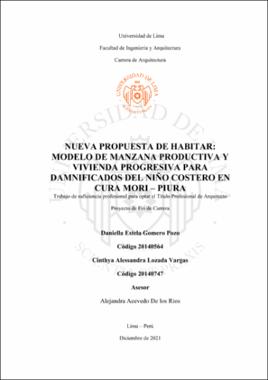Mostrar el registro sencillo del ítem
Nueva propuesta de habitar: modelo de manzana productiva y vivienda progresiva para damnificados del niño costero en Cura Mori – Piura
| dc.contributor.advisor | Acevedo De los Rios, Alejandra | |
| dc.contributor.author | Gomero Pozo, Daniella Estela | |
| dc.contributor.author | Lozada Vargas, Cinthya Alessandra | |
| dc.date.accessioned | 2022-05-18T15:19:28Z | |
| dc.date.available | 2022-05-18T15:19:28Z | |
| dc.date.issued | 2021 | |
| dc.identifier.citation | Gomero Pozo, D. E. y Lozada Vargas, C. A. (2021). Nueva propuesta de habitar: modelo de manzana productiva y vivienda progresiva para damnificados del niño costero en Cura Mori – Piura [Trabajo de suficiencia profesional para optar el Título Profesional de Arquitecto, Universidad de Lima]. Repositorio Institucional de la Universidad de Lima. https://hdl.handle.net/20.500.12724/15832 | es_PE |
| dc.identifier.uri | https://hdl.handle.net/20.500.12724/15832 | |
| dc.description.abstract | En el 2017, los habitantes del distrito de Cura Mori (Piura-Perú) se vieron gravemente afectados por el desborde del río Piura, ocasionado por las lluvias de El Niño Costero. La población reubicada se encuentra fuera de riesgo de inundación, sin embargo, cuatro años después siguen viviendo en situaciones precarias, sin un diseño urbano ni solución de vivienda definitiva. La tesis se aborda desde una investigación donde se revisaron lineamientos y manuales internacionales de vivienda, así como las teorías del habitar, del paisaje, el territorio y la memoria. Se diseñó un método replicable que incluyó el diseño de instrumentos como entrevistas, encuestas, observación, fichas de análisis de viviendas y talleres participativos. Aplicado en tres visitas de trabajo de campo a fin de conocer las lógicas de habitar y la identidad de la comunidad. El proyecto tiene como objetivo reconstruir la vida comunitaria de los pobladores, entiende la preexistencia de las memorias del poblador de Cura Mori: en el habitar cotidiano, las variables del territorio y la composición agrícola del paisaje, de modo que las reinterpreta y regenera en distintas escalas. Se propone un sistema urbano sostenible, organizado por escalas a partir de macro manzanas compuestas por cuatro manzanas con corazón agrícola, configurando una trama urbana a partir de patrones agrícolas existentes, incorporando parcelas de cultivo dentro del proyecto. A escala de vivienda se desarrollaron dos tipos de viviendas de crecimiento progresivo en tres etapas, incluyendo áreas destinadas para habitar, huertos y corrales. Se espera que esta investigación resulte de referente para el diseño de viviendas sociales y nuevas ciudades en zonas costeras con condiciones similares a las del Norte del Perú. | es_PE |
| dc.description.abstract | In 2017, the residents of the district of Cura Mori (Piura-Peru) were seriously affected by the overflow of the Piura River, caused by rains of the El Niño–Southern Oscillation (ENSO). Nowadays, the relocated population is not at risk of flooding, however, four years later they continue living in precarious situations, without an urban design or definitive housing solution. The thesis is approached from an investigation where international housing guidelines and manuals were reviewed, as well as the theories of living, landscape, territory and memory. A replicable method was designed that included instruments such as interviews, surveys, observation, housing type analysis sheets and participatory workshops. Applied in three field work visits in order to know the logics of living and the identity of the community. The project aims to reconstruct the community life of the inhabitants, understands the pre-existence of the memories of Cura Mori settler: in daily living, the variables of the territory and the agricultural composition of the landscape, so it reinterprets and regenerates them in different scales. A sustainable urban system is proposed, organized by scales from macro blocks composed of four blocks with an agricultural heart, configuring an urban fabric from existing agricultural patterns, incorporating cultivation plots within the project. At scale of housing, two types of progressively growing housing were developed in three stages, including areas for living, orchards and corrals. It is expected that this research will become a benchmark for social housing design and new cities in coastal areas with similar conditions of Peruvian territory. | en_EN |
| dc.format | application/pdf | es_PE |
| dc.language.iso | spa | es_PE |
| dc.publisher | Universidad de Lima | es_PE |
| dc.rights | info:eu-repo/semantics/openAccess | es_PE |
| dc.rights.uri | http://creativecommons.org/licenses/by-nc-sa/4.0/ | * |
| dc.source | Repositorio Institucional - Ulima | es_PE |
| dc.source | Universidad de Lima | es_PE |
| dc.subject | Arquitectura doméstica | es_PE |
| dc.subject | Diseño arquitectónico | es_PE |
| dc.subject | Arquitectura sostenible | es_PE |
| dc.subject | Arquitectura vernácula | es_PE |
| dc.subject | Urbanismo | es_PE |
| dc.subject | Planificación urbana | es_PE |
| dc.subject | Architecture, Domestic | en_EN |
| dc.subject | Architectural design | en_EN |
| dc.subject | Sustainable architecture | en_EN |
| dc.subject | Vernacular architecture | en_EN |
| dc.subject | Urbanism | en_EN |
| dc.subject | Urban planning | en_EN |
| dc.subject.classification | Arquitectura / Proyectos arquitectónicos | es_PE |
| dc.title | Nueva propuesta de habitar: modelo de manzana productiva y vivienda progresiva para damnificados del niño costero en Cura Mori – Piura | es_PE |
| dc.type | info:eu-repo/semantics/bachelorThesis | es_PE |
| thesis.degree.discipline | Arquitectura | es_PE |
| thesis.degree.grantor | Universidad de Lima. Facultad de Ingeniería y Arquitectura | es_PE |
| thesis.degree.level | Título Profesional | es_PE |
| thesis.degree.name | Arquitecto | es_PE |
| dc.publisher.country | PE | es_PE |
| dc.subject.ocde | https://purl.org/pe-repo/ocde/ford#6.04.08 | es_PE |
| renati.author.dni | 75746126 | |
| renati.author.dni | 72561986 | |
| renati.juror | Bonilla Di Tolla, Enrique Alfredo | |
| renati.juror | Ibarra Barack, Joanna Teresa | |
| renati.juror | Tejeda De Romaña, Sebastian | |
| renati.level | http://purl.org/pe-repo/renati/level#tituloProfesional | es_PE |
| renati.type | http://purl.org/pe-repo/renati/type#trabajoDeSuficienciaProfesional | es_PE |
| renati.discipline | 731026 | es_PE |
| dc.author.composer | ||
| ulima.cat | OI |



